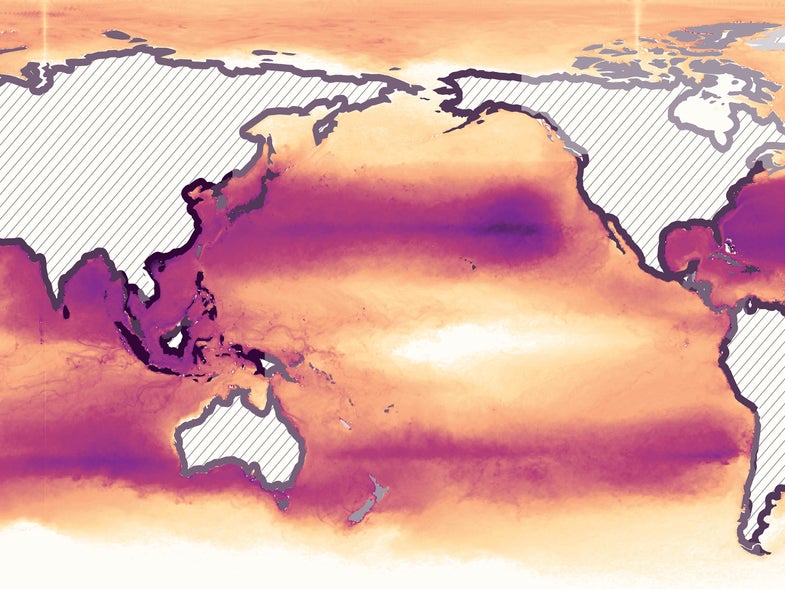Five Trillion Pieces Of Plastic Are Floating In An Ocean Near You [Interactive]
And even more lurks below the surface


Once And Future Ocean Plastic
In December, a consortium of 12 research institutions published some of the first numbers on global ocean plastic pollution. By their calculation, almost 300,000 tons of plastic swirl near the surface of our seas today–equivalent to the weight of about 1,500 blue whales.
“The ocean is covered in a thin layer of plastic,” says Marcus Eriksen, director of research at the Five Gyres Institute. “It’s like a plastic smog.” The pieces resemble confetti and are so dispersed they’re almost imperceptible, even when they collect in slowly rotating gyres.
Still, the estimate is lower than expected. It doesn’t include plastic that has sunk to the seafloor or been eaten by animals, for example. Some scientists think far more plastic–to the tune of five million tons–makes its way from our shores into the oceans every year.
Roughly 20 percent of small fish have plastic in their bellies
To figure out where all this plastic is coming from, University of Georgia environmental engineer Jenna Jambeck and colleagues recently assembled a model that shows potential points of origin. And in a business-as-usual scenario, the model shows that plastic flow will double in the next decade. So the moment to slow the influx–and engineer ways to clean up the existing mess–is now.
Below The Surface
Plastic isn’t evenly distributed in the vertical water column–some floats, some sinks, and some gets stuck in the middle. Most kinds of plastics, such as yogurt containers, break into floating fragments. Currents carry the pieces down a few meters, but they eventually float back up. Even taking those mixing currents into account, scientists find surface waters hold just a fraction of all ocean plastics.
Some researchers think the smallest bits of plastic neither float nor sink, but circulate in between. That’s because the pieces are so small, or their chemistry has been changed so much by ocean microbes, that they get dragged around by ocean flows.
Other kinds of plastics, like beverage bottles, immediately sink. Studies suggest the seafloor–typically 4,000 to 6,000 meters down–may hold far more than surface waters.
How To Deal With The Debris (Or Not)
Out At Sea
The trillions of plastic pieces in our oceans are incredibly spread out. “There’s not a persistent patch that you can go mine for trash,” Eriksen says. But the recent findings, paired with new circulation models, can streamline efforts to locate it. For example, nonprofit tech developer The Ocean Cleanup wants to use ocean currents to corral plastics into an array of anchored booms to concentrate and remove them.
65%: Ocean plastic, by weight, that lies north of the equator
On The Beach
Easier than trying to recover these practically irretrievable bits of broken-down plastic is keeping plastic stuff out of the water in the first place. In 2013, volunteers with the Ocean Conservancy’s International Coastal Cleanup collected more than 12.3 million pounds of beach trash around the globe, including more than 940,000 plastic bottles.
At The Source
Better yet, let’s curb plastic use altogether. The average American throws out 185 pounds of it every year. So while regulation may not be the sexiest approach to reducing waste, it’s likely the most tenable. After San Jose, California banned plastic bags, in 2012, bag litter choking the city’s storm drains dropped by almost 90 percent; it fell 60 percent in creeks and rivers. (Remember, those feed into the Pacific.)
Beyond Our Reach
Plastic’s interactions with sea life are more mysterious. Some species benefit: Barnacles and bivalves colonize floating plastic debris to create novel ecosystems. But sea turtles and sea birds die from eating plastic that clogs their digestive tracts. The biological impact of marine plastics, and how animals affect their movement in the water, are the next big questions scientists are striving to answer.
Interactive Map
Eriksen’s team, in addition to building a model of ocean plastics’ whereabouts, created a zoomable map of what they term “plastic smog.” Check it out:
This article was originally published in the June 2015 issue of Popular Science.
UPDATE—September 2017: Site security is important to us. For that reason, we needed to disable this interactive map, which is attached to a website without a secure connection. You can still see the infographic here.